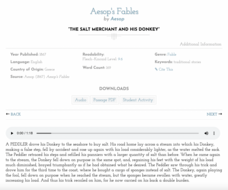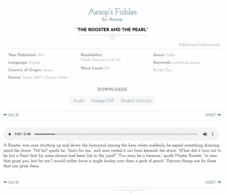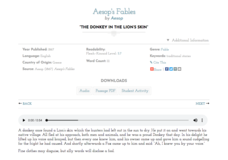Lit2Go
The Woodman and the Serpent
Does everyone always appreciate kindness? Part of a comprehensive series, Aesop's 136-word fable "The Woodman and the Serpent" tells the story of a snake that is rescued by a farmer and later tries biting the farmer's daughter. Readers...
Lit2Go
The Wind and the Sun
How powerful is kindness? Aesop's 133-word fable "The Wind and the Sun" is about a bet that is won by kindness between the wind and the sun to see who can make a traveler take off his jacket. Following the reading that is part of a...
Lit2Go
The Sick Lion
How should a disliked leader be treated when they're down? Aesop's "The Sick Lion", a fable about a dying lion being mistreated by his subjects, teaches readers about cowardice. The writing activity that has pupils produce an alternative...
Lit2Go
The Salt Merchant and His Donkey
Is choosing an easy path always the best decision? Aesop's fable "The Salt Merchant and His Donkey" challenges individuals to consider the question as they read about a donkey that makes choices to lessen his load. The writing activity...
Lit2Go
The Raven and the Swan
Turn ravens into swans, academically speaking, with a fable by Aesop and a narrative writing activity. The story a raven that is killed by his desire for white feathers is available to all readers as a short audio recording. After...
Lit2Go
The Rooster and the Pearl
How do individuals determine value? Middle school students read Aesop's fable "The Rooster and the Pearl" and complete a narrative writing activity to learn that precious things are for those that can prize them.
Lit2Go
The Milkmaid and Her Pail
Readers learn about idioms with a narrative writing activity that follows Aesop's fable "The Milkmaid and Her Pail." An audio version of the story allows learners of all reading levels to access the text.
Lit2Go
The Man, the Boy, and the Donkey
Working hard to please everyone often pleases no one, according Aesop's fable "The Man, the Boy, and the Donkey." After listening to an audio version of the story, individuals invent their own endings to the passage using a...
Lit2Go
The Man and the Wood
Pupils read about trees that give their means of destruction away to a man in Aesop's fable "The Man and the Wood." The activity after reading challenges scholars to create a narrative with a new ending to the fable.
Lit2Go
The Lion, the Fox, and the Beasts
Does wisdom grow from the misfortune of others? Pupils read Aesop's "The Lion, the Fox, and the Beasts" and write a personal narrative about a time where they learned something from another's experience.
Lit2Go
The Fox and the Crow
Aesop's fables are full of tricky foxes, and "The Fox and the Crow" is no exception. Individuals listen to an audio passage and write either a fable or a personal narrative about a time they wanted a friend to share something with them.
Lit2Go
The Donkey in the Lion’s Skin
Have you ever tried to be someone you're not? Aesop's "The Donkey in the Lion's Skin" features a donkey who dresses up as a frightening predator—but whose loud bray betrays his identity. Learners stop reading before they reach the ending...
Lit2Go
The Hare and the Tortoise
Does slow and steady really win the race? Class members listen to an audio version of "The Tortoise and the Hare" before completing a math activity, which prompts them to calculate distance, rate, and time. A writing assignment prompts...
Lit2Go
The Goose with the Golden Eggs
Aesop gives golden advice in a fable about greed. After listening to the audio version of "The Goose with the Golden Eggs," pupils practice writing new resolutions to the story.
Lit2Go
The Fox, the Rooster, and the Dog
What happens when a tricky rooster tries to outsmart a cunning fox? An audio retelling of Aesop's fable "The Fox, the Rooster, and the Dog" inspires learners to think about any deception they may have used in order to get what they want....
Lit2Go
The Fox and the Cat
Would you rather have one safe plan or one hundred possible options? Learners read Aesop's "The Fox and the Cat" and write either a narrative story or a fable about a time when they had many choices, but could only choose one.
Lit2Go
The Donkey, the Fox, and the Lion
Learn about the value of teamwork with Aesop's "The Donkey, the Fox, and the Lion." After listening to an audio retelling of the fable, pupils write an alternate ending and share with their peers.
Lit2Go
Avaricious and Envious
Wishing harm on your neighbors is never the best way to better your own situation. Two neighbors learn this lesson the hard way in Aesop's "Avaricious and Envious," which reinforces the connection between vices and punishment. Pupils...
Lit2Go
The Dog in the Manger
Have you ever refused to share something you didn't need? An audio version of Aesop's "The Dog in the Manger" explores a similar situation and prompts class practice narrative writing skills with a short story about a time they did not...
Lit2Go
The Bald Man and the Fly
How should you deal with an enemy? Aesop's "The Bald Man and the Fly" presents one method that ends up hurting the victim even more than the perpetrator. Before, during, and after listening to an audio version of the story, learners...
Lit2Go
The Ant and the Grasshopper
What will the ants do when they hear the sad song of the leisurely grasshopper during the winter? Aesop's "The Ant and the Grasshopper" is the foundation for an activity that allows learners to either rewrite the ending to the fable, or...
Townsend Press
Purpose and Tone
A powerful image or well-placed comment always has intention behind it. Guide young readers through author's purpose and tone with a language arts video that explains why word choice is key in writing clearly and coherently.
Andrews McMeel Publishing
POW! A Peanuts Collection
Make a study of Charles M. Scultz's famous comic strip Peanuts in your language arts class. Class members read and discuss the baseball-themed book POW! A Peanuts Collection. After talking about themes and vocabulary, they complete...
Imagine Learning Classroom
Learn Zillion: Write a Conclusion for a Narrative by Showing How You Feel
In this lesson, you will learn how to to create strong endings for your narratives by showing the reader how you feel. [4:50]























